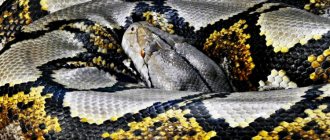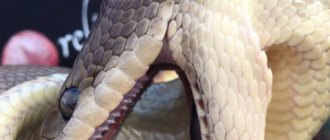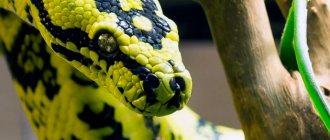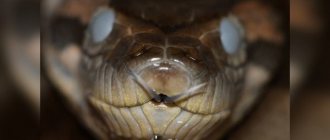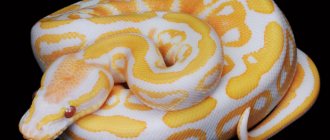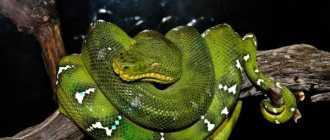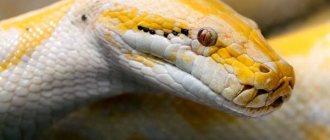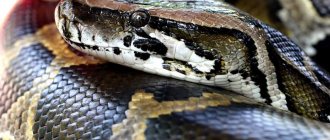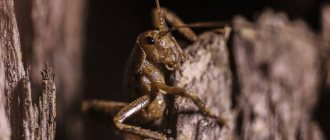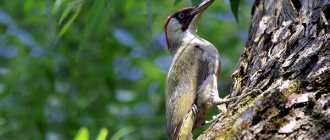How does a snake kill its prey?
By wrapping their coils around the victim, snakes strive not so much to block the access of air to the lungs as to stop the flow of blood. We are used to thinking that pythons and boas strangle their prey in their arms, and from the outside this is exactly what it looks like: the victim seems to be suffocating, gasping for air.
Interesting materials:
How to set a ringtone on Lenovo a 1000? How to set a ringtone on a tablet? How to put multiple statuses on WhatsApp? How to put classmates on the desktop? How to install Opera on Android? How to put a password on a Word document? How to set a password for YouTube on Android? How to set a password to turn on a Samsung TV? How to put a plus on top? How to put a plus in a cell?
veralline.com
Let us immediately clarify that the anaconda belongs to the subfamily of boas, but in this comparison we have singled out this snake separately because of its size.
Python
Python is a snake from the non-venomous family. In total, today there are 9 genera and 41 species. Pythons are common in sub-Saharan Africa, Asia, and Australia. They live, as a rule, in tropical forests, savannas, and swampy areas; a small number of species live in deserts. Pythons often settle near water; swim and dive well. Many species crawl on trees; There are also almost entirely arboreal species. They are active mainly at dusk and at night. The size of this large snake is from 1 to 7 and a half meters. The color is very diverse: from more or less monochromatic (brown or brown-brown tones) to quite variegated - spotted; tree species (green python) can be green. A special feature of pythons is that they have two lungs, like a person’s, while most other snakes do not have a left lung, and the right one is expanded and elongated. Unlike boas, pythons have teeth. They feed mainly on mammals (large pythons can swallow jackals, young leopards, porcupines, etc.), as well as birds and large lizards; young pythons eat small rodents, lizards, and, less commonly, frogs. They catch prey by grabbing it with their teeth and simultaneously squeezing it with the rings of their body. The python swallows its prey whole, which is facilitated by the structure of the jaw apparatus of snakes. Pythons are capable of swallowing very large prey and then digesting it for quite a long time. Pythons, like many snakes, are capable of going without food for a long time (up to 1.5 years). Female pythons are usually larger and more powerful than males. During mating, the male rubs his body against the female and scratches her with anal spurs (bone rudiments). All pythons are oviparous. A distinctive property of pythons is the ability to incubate a clutch of eggs, and due to contraction of the body muscles, the temperature of the clutch is 12-15 °C higher than the ambient temperature. The hunt consists of the fact that the python lies in wait for its prey, and when it approaches, it pounces on it with lightning speed. Strangulation occurs as follows: the snake grabs its victim, curls it into coils and does not allow it to move. As soon as the victim exhales, the rings compress and, as a result, the trapped creature can take a smaller breath. With the subsequent exhalation, the rings compress even tighter and this happens until the victim suffocates. Pythons are popular terrarium animals - they are kept both in zoos and by terrarium keepers at home. These snakes tolerate captivity well and can reproduce successfully. There are known cases of python attacks on humans.
Boa
The boa constrictor is a non-venomous snake, part of one of the families of pseudopods. To date, 13 genera and 53 species of this large snake are known (including the anaconda.) A distinctive feature of the boa constrictor is oviparity, that is, the female does not lay eggs, but carries them inside herself; boa constrictors hatch inside the mother. There are several types of boa constrictors; we will give a comparison description of the common boa constrictor. Distributed in South and Central America and the Lesser Antilles. Prefers to settle in dry places, but close to water bodies. He took root in Florida (US state). It reaches a length of 2-3 m in captivity and up to 5-5.5 meters in nature; females, like many snakes, are larger than males. Externally, boas are similar to pythons, the color depends on the habitat. Only a specialist can distinguish a python from a boa constrictor (but in any case, these are snakes of different species and families). The python has teeth and supraorbital bones (some species of boas also have teeth, but less pronounced). In boas, the eyes are not protected by either a prominent bone or scutes. Hunting style, eating prey, etc. in boa constrictors it is the same as in pythons, that is, the boa constrictor grabs its victim, curls it into rings, thereby killing and swallowing whole. As in the case of pythons, there are known cases of boa constrictors attacking humans.
Anaconda
Anaconda is the largest snake currently existing and belongs to the boa constrictor family.
Because of its habitat, the anaconda is sometimes called the water boa. The snake lives throughout tropical South America east of the Andes: Venezuela, Brazil, Colombia, Ecuador, eastern Paraguay, northern Bolivia, northeastern Peru, Guyana, French Guiana, and the island of Trinidad. There are many previous reports of anacondas measuring 9 or 11 meters in length, but animals of this size have never been measured. The largest anaconda caught reached 97.5 kg with a length of 5.21 meters. The maximum that anacondas can reach is estimated at 6.7 m in total length or 5.3 m in length excluding the tail according to various studies - slightly higher than the size of the largest specimens that have fallen into the hands of scientists. The color of the anaconda is grayish-green with two rows of large brown spots of round or oblong shape, alternating in a checkerboard pattern. On the sides of the body there is a row of smaller yellow spots surrounded by black rings. This coloring effectively camouflages the snake when it lurks in calm water covered with brown leaves and tufts of algae. As a rule, it inhabits hard-to-reach places; for this reason, it has not yet been studied much by scientists. Anaconda leads an almost entirely aquatic lifestyle. It lives in quiet, low-flowing river branches, backwaters, oxbow lakes and lakes in the Amazon and Orinoco basins. In such reservoirs, the snake lies in wait for prey. She never crawls far from the water, although she often crawls out onto the shore and basks in the sun, sometimes climbing onto the lower branches of trees. The anaconda swims and dives well and can remain under water for a long time, while its nostrils are closed with special valves. The anaconda feeds on various mammals and reptiles, lying in wait for them near the water. It usually catches rodents, waterfowl, birds, iguanas and other small animals. It also attacks larger animals, but less frequently. These could be crocodiles, antelopes, etc. The anaconda also hunts snakes, including other anacondas. It swallows its prey whole. There are known cases of anaconda attacks on humans and domestic animals. Several cases have been officially registered, for example, an anaconda swallowed a 13-year-old boy. It should be borne in mind that attacks of large snakes (and not only anacondas) on humans remain largely unregistered, since this usually happens in hard-to-reach places, in the deep jungle.
Anaconda from South America
In the same Hollywood, films were also released about a gigantic anaconda attacking people from under the water of a river. But this snake lives in the jungles of South America, and is shorter than the reticulated python. An anaconda once swallowed a 42 kg puma in Brazil. Boa constrictors have the same attack methods.
Video "Anaconda vs. crocodile"
Green python in New Guinea
In the forests of New Guinea there lives a green python, very beautiful. The emerald-colored scales of the boa constrictor are sometimes spotted with white spots. The length of the kite is no more than 1.5 meters. It usually hangs on the branches, curled into rings. Hunts lizards and frogs, does not disdain small rodents. When attacking a victim, it strangles and then swallows.
New Guinea pythons are not all green; there are some with blue scales, skin, and orange and yellow ones. When several colorful boa constrictors hang on tree branches at once, it resembles a reptile masquerade.
Asian reticulated python, up to 8 m
The Asian reticulated python
has long been recognized as the longest snake in the world . It received this name because of the complex pattern on its body.
Naturalist Ralph Blomberg wrote about a snake 33 feet long, i.e. 10 m. But there is no information confirming this. So the python from the Philippines, more than 14 m long, turned out to be 2 times smaller. In nature, these snakes can grow up to 7-8 m in length.
In the south of Sumatra, more than 1 thousand wild pythons were measured, their size ranged from 1.15 to 6.05 m. One of the largest was caught in Indonesia - 6.96 m, weighing 59 kg. The record holder, as mentioned above, is Samantha. But there was another reticulated python 9.75 m long, which was shot on the island. Celebes in Indonesia in 1912. He got into the Guinness Book of Records.
5 0
Nutrition
These amazing creatures feed on fish, amphibians, small iguanas, turtles and even other snakes. They catch birds, parrots, herons, ducks, and aquatic mammals such as capybaras and otters. It can attack a young tapir, deer, peccary, or agouti that comes to drink. She grabs them by the river and drags them deep into the depths. It does not crush bones, like other large snakes, but simply does not allow the victim to breathe.
Having strangled the prey with powerful embraces, it swallows it whole. At this moment, her throat and jaw stretch quite significantly. And then the boa constrictor lies at the bottom for a long time, digesting food. The strange thing is that, living in the water element, he prefers to eat the inhabitants of the earth's surface.
When free, the snake feeds only on fresh prey. And in captivity it can be trained to eat carrion. Cases of cannibalism have been observed in these reptiles. Cruelty and the desire to survive are their main principles when hunting. Adult anacondas have no natural enemies, except humans, of course. He hunts them for their beautiful and thick skin.
And young anacondas may have enemies in the form of crocodiles and caimans, with whom it competes on the territory. May be attacked by jaguars, pumas. A wounded snake can go to piranhas.
Among Amazonian tribes there are legends about tamed predators. They say that a reptile caught from a young age can live next to a person. Then she helps him, protecting the home from small predators, and the utility premises - warehouses and barns - from rats and mice.
For the same purpose, they were sometimes launched into the hold of a ship. Quite quickly the animal helped free the ship from uninvited guests. Previously, such reptiles were transported in boxes with holes, since they could go for long periods, up to several months, without food.
Geographical distribution
Photo: Matthieu Berroneau
Anacondas live exclusively on the South American continent. Each species has its own unique range, but researchers aren't entirely sure of the exact range of some of the more hidden species. In general, these snakes can be found throughout the Amazon River basin and surrounding areas.
- Bolivian anaconda: Bolivia
- Dark spotted anaconda: French Guiana and northern Brazil
- Green anaconda (of the four species it has the widest habitat): Amazon and Orinoco river basins, Colombia, Venezuela, French Guiana, Ecuador, Peru, Bolivia, Trinidad and Tobago, Paraguay
- Yellow anaconda: parts of Brazil, Bolivia, Argentina and Paraguay.
Boas and pythons in Africa
There are giant snakes in the African jungle. But there are cobras that spit venom into the eye and blind a person if they fail to bite. Africans hunt pythons of any size, and when killed, several people carry the body of the snake to the village. The Aboriginal weapons are spears.
Boas in Africa grow up to 6 - 7 meters in length. The python has 118 pairs of ribs, and it moves on them, and quickly. It strangles the victim with its ribs.
The African python almost never attacks people. It happened that a boa constrictor ate children, swallowing the human body whole. Once he swallowed a soldier in uniform. In 2002, a snake attacked a 10-year-old child, eating the boy.
The python does not have poisonous glands; its smallest species is only one and a half meters long. Boas hunt at night, attacking small rodents.
Many zoos around the world keep Royal pythons, but there are people who decide to keep similar boas at home. The snake loves warmth, and if you feed it, this reptile is usually quite peaceful. Of course, to keep a python you need a terrarium, and not to give it an apartment at its full disposal.
Africans talk about pythons over 10 meters long! Such a snake can swallow an antelope whole. The boa constrictor hunts from an ambush, quickly overtaking the victim, breaking its ribs and swallowing it. Straightening up like a spring, the python can jump a considerable distance. It can also float on water.
Habitat
Anacondas lead an amphibious lifestyle (they rarely climb trees due to their enormous body mass). All four species occupy similar habitats. Their favorite ecosystems are rivers, streams, lakes, swamps and flooded regions. Their dull-colored scales provide them with ideal camouflage in turbid waters rich in aquatic vegetation.
Anacondas can swim at a speed of 20 km/h and can stay underwater for up to 20 minutes. They sometimes crawl out of the water to hunt or sunbathe in tropical forests, savannas and grasslands.
Light tiger python, up to 3 m
Tiger pythons are non-venomous snakes that can be found in Asia, in tropical rainforests. Snakes hide in holes, in tree trunks, and can climb trees. They usually live near bodies of water and are excellent swimmers. They eat small animals: various rodents, birds, monkeys, kill them, suffocate them with their bodies.
There is a subspecies of these snakes - light tiger python , also called Indian . It has a light coloration, dominated by brown or lighter yellow colors. Large individuals can grow up to 4-5 m.
Bushmaster, up to 3m
The largest venomous snake in South America is the bushmaster or, as it is also called, surukuku . Meeting her is not so easy, because... she leads a solitary lifestyle and prefers uninhabited territories. Its skin is covered with ribbed scales, yellowish-brown, and a pattern in the form of brown diamonds is visible on its body.
The usual length of the snake is 2.5 -3 m, but sometimes reaches record sizes of up to 4 m. It weighs from 3 to 5 kg. It can be found in dense tropical forests, close to water, during the day it mainly hides in dense thickets. It goes hunting at night, catches rodents, and can eat birds or other snakes. Its poison is dangerous, but the mortality rate from it is not so high, no more than 12%.
